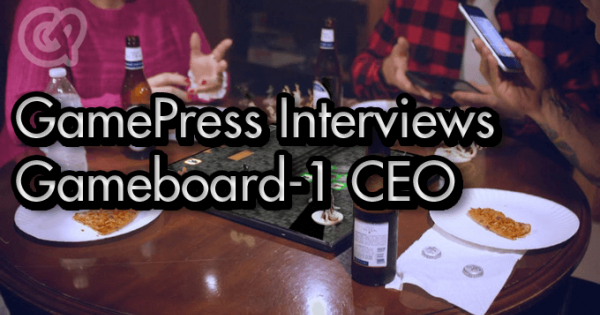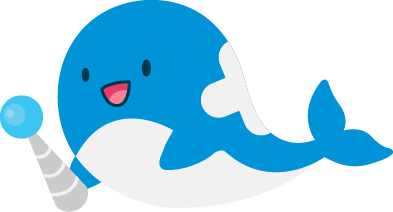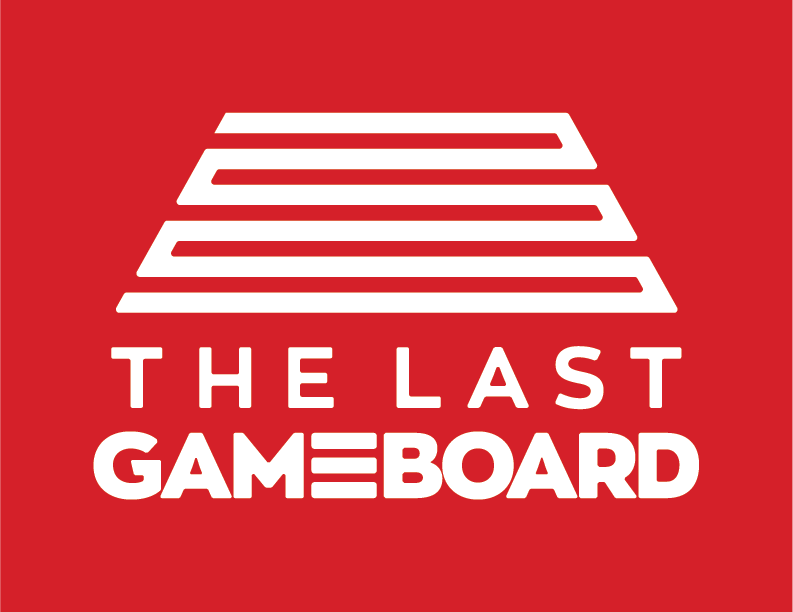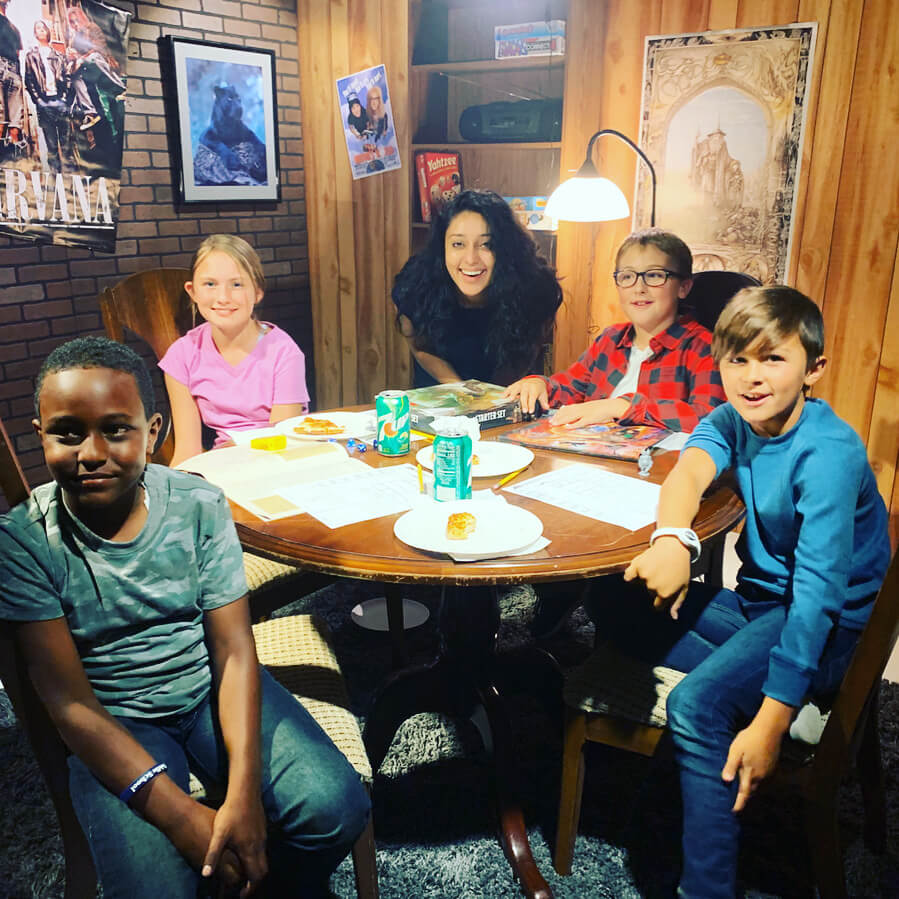The Future of Board Games: An Interview with Gameboard-1 CEO Shail Mehta

- An interview with the innovative Gameboard-1 CEO that talks about the future of the project, hurdles overcome, and the tech that makes it work
- The Gameboard-1 is on the last few days of its Kickstarter campaign, which ends on November 8, 2019.
- A live stream of it in action will be conducted on the evening of the 6th!
- UPDATE [11/09/2019] : The Kickstarter was a success! Take a look at the link to see where to go for more information!

On October 5, 2019, The Last Gameboard launched their Kickstarter for a brand-new piece of technology designed to help board game enthusiasts take their play virtual in a way never experienced before.
Gameboard-1 is a tablet screen designed specifically to bridge the gap between the digital and physical space for all your games. Players can place figurines, dice, or cards on the screen itself to cause unique interactions thanks to the patented Sense Screen technology it incorporates. Gameboards can even connect to each other to allow for gameplay that crosses the globe, or to build an epic 2 x 2 game screen for larger playing areas.
GamePress sat down with Shail Mehta, CEO of The Last Gameboard, to talk about the process of recruiting developers to their platform, the technical hurdles they're overcoming, and what to expect next.

The Interview
You know, y'all are in the home stretch of your Kickstarter campaign. How has the reception been? Have you been receiving the community response you've expected?


Yeah, you know, I had an inkling of before I started the Kickstarter about how excited I thought developers and the community would kind of be. I've been a little overwhelmed with how much people are invested in this and it's kind of beautiful to see so many people just sharing our vision. For the past 18 months, it's been our team working on something that we think that there's a market fit for and to see hundreds of people come out and talk about, "Not only is this something I've always thought of, I've always though something like this should exist." That's like the number one comment that we get is, "Oh my God, I thought about this five years ago, I can't believe it hasn't come on market and now it's becoming a reality!" to getting into really technical and detailed questions with us, which I think is amazing. It's just such a humbling feeling to to have so many people share the vision with us and it adds to the weight of what I think our responsibility in delivering a quality and incredible product is as well. So it's been amazing and I'm so excited for the community's continued response.


Project Challenges
Well, that's really great to hear. Yeah, we're all really excited as well. Yeah. What kind of challenges have you encountered through the course of the campaign?


I think the biggest thing is differentiating ourselves and making sure that our messaging is correct. I think that a lot of the questions that we got initially on were how is this different than a screen? How is it different than an iPad? And really communicating a lot of our value props, because once the campaign started unfolding, I realized we had so many differentiating features and so much to offer in terms of value. But really, giving the ability for people to digest that in waves is something that we learned throughout the campaign. It's like how do we message all of the cool features of the game board without overwhelming and saturating it and just get people all the right information? How do we provide clear messaging around what the board can do has been something that we've learned through the [campaign's] duration.


That's great. Yeah, you know, there really is you could say there's an art to running a Kickstarter these days with how much there is on the line! How many people get involved it really is quite a big conglomerate experience.


Yeah, and I didn't realize it's like a machine right? I'm just like, "Hey, we just want to do this for the community and we want to get people excited and find that core base, and then really, you know, scale from there" and it's this perfectly fine-tuned machine that I walked into and like, "Oh, you do this at this time and this at this time" and I had no idea! I'm walking in there and it's just like, "Yeah, this is going to be great! I just want - this is all about community, community, community!" And it still is, but it was such a cool thing to learn how much people have made Kickstarter this complete algorithm or complete business package I guess to walk into. For us, it was just coming in and showing how cool our product is and talking about our tech and engaging our enthusiastic backers about it. And that still remains a priority for us more than, you know, the business side of things.


That's fantastic. So, going into tech for the Gameboard-1, we saw that the it will support internet connectivity to allow players to play across the world with each other. But in terms of the content on the Gameboard itself, will there be region specific content or a store? Will it be region locked?


It will depend on IP licensing restrictions for individual game studios. So you get this with online and digital games. We work a lot with gaming companies that already have acquired digital licenses for hard [physical] games. So if there's a restriction in their IP that they're not allowed to have in certain regions or countries then we will have to respect that as well. Because it's [effectively an] extended license for their already obtained IP. So I think there might be some differentiating but it depends game to game and region to region what the restrictions are.


So onto those game companies, you have a very verbose list of game companies that you're working with. Is there anything you can tell us about the process of recruiting them to work on the Gameboard specifically with names like Cryptozoic - very big heavy hitters in the board game industry. Was it challenging to get a lot of developers to commit to the project?


We started this process earlier on. We called it our Alpha Program and it was January of this year [2019] when we started and it was to not only identify people that were looking to expand their customer base and their revenue base but also looking to merge the digital and physical. So when we first set our path to find companies that were best aligned with us, we were really specific on companies that would immediately see our value proposition and kind of be in the same path to what we wanted to do as well. So I think one of the main things is making, you know, I say this all the time with Gameboard, and what we do with our companies is, "Interests must align", right? So they have to see the value proposition and we have to provide the opportunity for that, and vice versa. And I think a lot of the game development studios are on a similar path. They see this evolution of physical and digital emerging, but they want to retain this aspect of social face-to-face interaction and not being just virtual at all times and having virtual things in front of you. It's about this interaction and using technology to enhance it. And we started this process a long time ago, in the hopes that we can walk companies through our evolution and they can help us kind of shape not only the OS, but what a game would look like - how would it work - what are the constraints around it? What do they look for? And it kind of helped us shape it to where we are today. And that's what we want to continue to do. We want to use the development community that we have to shape the user experience for our customers, because they know their games the best. And what we want to do is provide the sandbox for them.


Wow, that's really amazing. So you've had input from the developers from a very early point in the development process?


Yeah, absolutely. And I want to continue that, because I think it's valuable. I think that understanding how a game works, the developer knows best. What we can do is provide what our hardware and what our software can do, and just amplify the experience that people have on it. So we didn't want to dictate to a game developer, "This is how you must build and this is the code that you must use." We wanted it to be more of a collaborative experience. So in that way, it's truly startup in its nature. This platform is merging these communities together to provide a really amazing experience for the end consumer.



Hardware
That's great. So onto the screen itself for the Gameboard. So you have this Screen Sense technology. How is it distinct from other touchscreen devices like an iPad? It sounds like the tracking it sounds very robust. Can you give any details into the specifics and how it works?


So the easiest way to understand it is how we interact with the touch screen today. We're limited by the touches and our fingers or a stylus. And I know other people have tried to do you know, like amiibo and all that stuff. They've done RFID active pieces on a touchscreen. And what it's done is it unlocks a feature on a touchscreen, it doesn't interact with it, like your fingers would. It's not as interactive and immersive. And other companies that have tried to merge this physical and digital tend to have tons of latency because they're doing the same thing. They're using existing touchscreen technology, and embedding RFID tags onto physical objects. It causes a bad user experience. And that's what we fix with Sense Screen. The way you interact with a touch screen with your fingers is how we wanted that user experience to be with physical objects. So without getting too much into our patent and the 'secret sauce' of it all works, it's an elevated form of a touchscreen. So no, an iPad cannot do what we do. And a touchscreen on your computer cannot do what we do. We have a completely new patented way that physical objects with or without batteries can be detected, understood, and used on the Gameboard, which does not exist today.


That's really impressive. So the devices, or not even just devices, but any kind of object that has a unique base can be detected by this technology?


Correct. Yeah. And the minis or the figurines, whatever you want to call them, that have these tags embedded into them, they correspond just like anything would. They correspond with each other, they correspond with the game, they correspond in a space that exists even outside of it. So retaining information about gameplay mechanisms, IDs, you can essentially put physical intrinsic value to digital assets. So that's our next wave and and that's what we really want to push with what the Sense Screen technology can do. And I think we touched on it on this Kickstarter. But there's so much more to what the tech is capable of. And I think it's important for us to roll it out as to not overwhelm people. It's so much information and digesting in waves is important, but there's so much more that the Sense Screen can do and, and what it can do with physical objects and I hope to share that a lot more as we move forward.


Oh, that's amazing. Thanks for the explanation! So on to the Kickstarter content itself. In an update that was posted previously before the most recent one, you spoke about larger backer reward tiers granting multiple Gameboards. Three and four I believe were the two bundles, as well as broke down kind of the process by which the game board was made. Is manufacturing a product like the Gameboard something your team has a lot of experience with?


Yeah, the three and four we released because people asked us to we got so many comments from people saying that, "Hey, I reserve one from the early bird or from the $349 pledge, how do I get more and get more we can access?" So that's when we were, "Well, if we're getting this many comments about it, we should just release more tiers about it." That way we don't have to deal with individual backers on the back end. It just makes it easier for the consumer and it makes it easier for us as well. So that's why we decided to release more larger backer rewards - because people asked us to. Initially it wasn't a part of the campaign. And yeah, the update had a lot to do with our manufacturing because I think it's important on Kickstarter for people to know: hardware companies are hard. And you know, we've done the hardest part which is figuring out the hardware, figuring out the patent, and figuring out the manufacturing and the supply chain. Because our team has not only built gaming hardware products from the ground up, they've scaled them. So as you know, one of the leaders on our team is Rob and his experience comes from the first Xbox and Magic Leap and all these other gaming consoles. And what he's done is not only create the initial architecture of it, but he's been there to understand what it's like to scale to a larger supply chain as well. So he understands the ins and outs of manufacturing that and it's not just some people trying to, "Hey, this is cool tech, let's see if it works." We've done all the hard part of this product, and we just want to bring it out at this moment and Arrow is a huge part of that. So they're a distributor, they've worked with us for the past 18 months on sourcing components. And we've actually worked with them on locking in various levels of what a price of an individual component would be, how does that get locked in for a year? And how do we hold that price? How do we protect against external moving pieces to make sure that this product is in the price range and in the way that it needs to be shipped to the consumer? So much work for the past 18 months has just gone into hardware and supply chain and making sure that this product comes out in a way that we want it to.


On to the hardware itself, you know, the Gameboard-1 is a very impressive piece of equipment. The connectivity between the screens is very fascinating, but we kind of wanted to ask about the bezel specifically. You know, there's a lot of space in between the screen and the actual border of the unit for a lot of other electronic devices. So is the bezel gonna be actively refined during production for this device and can the community count on it being as slim as possible?


Yes, that is a huge focus for us. Our prototype has a bezel and that's where we are with it. But when the product comes to market, we are trying to get this bezel as small as possible because we want the user experience when people connect the boards is to virtually not be able to see the bezel at all. So we will work really hard to make sure that when this product comes out next year, that bezel is as slim as we can make it without compromising the tech and the hardware of it. We still want to make sure the user functionality of it is first and foremost, but then having that user play experience of merging boards together is very important.


In terms of the hardware itself - the internal hardware. What kind of future proofing are you doing to prepare for the Gameboard-1's release? Are you concerned about its ability to take on more taxing applications and games?


Yeah, I think we see the game board as having maybe a two or three year life cycle at minimum. And that means looking at it from the point of the game developers. What do they need in terms of processing? What do they need in terms of graphics and data? And how can we evolve to make sure that the game is working for the end consumer? So we have this larger plan and I think it has a lot to do with...our COO called it metagaming, and we keep laughing at him because he loves the term, but it's this idea of having a community like an Esports thing, but more tournament stuff - because network plays a huge part in this. So being able to play people across the world across countries, and your pieces are physical, and you see their digital representations and vice versa. I think it makes for a really cool experience for tournament style play, especially when D&D and like more RPG games are involved. There's a lot of cool things that we can do with it. So we've always had this idea of making sure that the board can keep up with the demand and how the consumers want to move forward with it. And the hardware specifically is designed to be able to implement future versions of software updates.


So there will be a firmware updates and other support planned for the future?


Absolutely. A lot of our plan for 2020 and onwards is more on the R&D. We're constantly going to be looking at refining the product and making sure that the user experiences is what people are demanding and making sure that we keep up with it at every step. And already we're getting questions about battery life and "Can I have more variations in battery?" and "Four hours is not enough. I want six, I want eight." So we're already looking at that to increase our values in the hardware as much as we can. The good thing about it is it's a big space [to work with]. So we can increase the battery size as much as we need. We just don't want to have, you know, a really expensive product on people's hands.


In terms of the specifications of the Gameboard-1, what can consumers expect in terms of refresh rate, response time and touch latency?


So touch latency is something that's really important to us, and there will be no visible latency on the Gameboard. And that was actually a huge important factor when using physical pieces - Is not to have this trailing response. Even if it's for you know, a second, you notice it. Because your eye, it's not moving as fast as you would in the real. So it was important for us to have that. So the screen refresh rate is 60Hz, our tech refresh rate is 100 Hz, so there's no visible latency. We know that people are looking for higher refresh rates, especially when it comes to gaming, but it depends again on our game development community. If we have enough game developers who are moving more into fast motion 3D graphics or visually intensive work, then we will support that. So, it depends on where the games move. Right now the 120 Hz is not required for the games that we have. But if we do [see it's required,] then we will push for it as well.


Fantastic! What kind of cooling do we expect to see on the Gameboard? Will it have passive or active cooling?


So we plan on using passive cooling as much as possible. One of the cool things about the Gameboard is that the available surface area kind of disperses a lot of that heat. We do have fans that will kind of kick it out of the processor gets too hot, but we don't want to throttle the performance. Making sure that the thermal and the heat issues are being taken care of as was primary when we designed hardware.


In terms of display options, will the Gameboard-1 support displayport via USB-C? And will it support input output with connected hardware such as other touch screens or computers?


Yeah. So and you know, this was surprising. I think this is when you asked earlier, what was some of the surprising things - I think a lot of us making sure that people are understanding our value proposition, we don't want this just to be like an extended screen, right? Just an extended display because you could do that with anything else. For us, it's about having the Gameboard be the motherboard for all the games that are working on it. The core processor, the core computing hardware. So it's not as much an extended display for Gameboard-1 but we will support, and I think a lot of that comes from the questions of, you know, "Can I can I stream the games that I'm playing? Can I stream Twitch? Can I stream eSports style games on there?", and that we definitely want to support. But I think it's not a good use of the Gameboard to just use it as an extended display.


There is some really neat utilities there as well. You know, in terms of Twitch streaming a D&D campaign, for example, being able to stream that Gameboard directly to a web browser would be a very interesting way for viewers to interact.


Yeah, and I think that's a huge part of it. And we definitely want to be able to support that and I think it'd be such a unique experience. I think people are doing that so much with video games and eSports, to do it with like D&D or Magic the Gathering or Hex or anything like that, that's online where people can see it in the larger arena setting, is such a cool experience and we will hundred percent support that.


Development and Collaborations
One of the most popular board game services / electronic board game services out there is Tabletop Simulator for Steam. Do you anticipate Gameboard-1 interfacing with Tabletop Simulator?


We'd love to. Yeah, I mean, I think they're built on Unity. [Editor's note: It is!] And I think that play testing is a huge part of what we're doing. Tabletop Simulator has such cool features and it has such cool games that I think it would be amazing to have them integrated on the Gameboard. I think their tech perfectly aligns with what we're doing. And we're in 2D, they're in 2D [Editor's note: And in 3D & VR!], it's a Unity based thing, and I think it'd be perfect on the Gameboard.


And finally, in your last Kickstarter announcement, you mentioned a partnership with The Game Crafter, which sounds like a really interesting service allowing players and designers to commission and customize their own games and pieces. Can you give a few examples of what kind of exclusive tech they might be able to create, involved with the Gameboard-1, specifically with The Game Crafter?


So what we really want to do is streamline things for game developers. We don't want them to have to hunt for, "How do I integrate these tags into physical pieces? What do the pieces look like? What is the size, the shape, the weight? How do they integrate onto the Gameboard?" Our goal with Game Crafter is to make sure that we're offering a packaged, streamlined approach to anyone who wants to integrate physical pieces on the Gameboard. So they have an expansive inventory of game pieces. And what we want to do is integrate our tech into it. These tags that get embedded into the bottom of them could be readily available through Game Crafter for anyone that wants to build and use them on the Gameboard. So if you have a digital asset of a game already, and you want to integrate five hero pieces because you're estimating five game players can play on the Gameboard, then you can go to Game Crafter and see the pieces that are there. The tech is embedded and you can use them on the Gameboard. So it's this way to just give a really streamlined approach to any developer without having to hunt for new tech. One of our goals always has been to limit barriers. So from the software, the development side, and now with the physical piece side, to lower barriers for developers to build on the Gameboard. That's been our goal from the beginning and Game Crafter just perfectly amplifies that.


That's so cool. What do the tags look like actually, outside of the pieces?


They're just ... honestly, they're just black and round and you wouldn't think that there anything unique about them. You wouldn't think that there's anything special about them. They're super lightweight and they're dime size and you can just stick them on to the bottom of things. Actually, to the naked eye, you wouldn't see that much differentiating factors with them. And I think that's kind of the cool factor with the tech as well. It doesn't seem that it's that complicated or its that unique and that's a part of what we wanted to do. We don't want people to sit there, and I think I think Rob said it best when he said that, "If people just play on the Gameboard and it just works, we did our job." You don't want to overcomplicate this for the end user. For this, it should be a seamless user experience. And for us, that's foremost; the ability to just integrate physical pieces, to turn on the Gameboard, play any game that you want, sync your personal device, the experience overall should be something that's just intuitive. And we've had decades in our society of working with touchscreens and we just want to build on that tech and offer this evolution of a touchscreen device with tabletop gaming. And our entire mission in this is to provide just a seamless user experience.


Last Calls
All right, amazing. Thank you so much for your time today. Shail, we really appreciate it. Is there anything else that you'd like to add or anything that you'd like to throw in at the end? Maybe what to expect from the last final days of the Kickstarter?


So we're doing a 'Town Hall' tomorrow [11/6/2019] 7 pm Central Time where we talk more about the tag, take questions from the community, and show more of the tech and just kind of answer a lot of last minute questions that backers might have. So tune in tomorrow at seven central time [November 5th, 2019 at 7 PM CST]!


Conclusion

To head directly to their Kickstarter page, click the link above!
So there you have it! The Gameboard-1 is definitely some promising tech that will not just bridge the gap between physical and digital mediums, but looks to provide creative developers with an opportunity to seek completely new ways to engage everyone! As Shial mentions, be sure to check out the 'Town Hall' stream happening this evening here. [Edit: A recording of the Town Hall can now be found on Facebook, here!]
Her and the rest of The Last Gameboard team have put a lot of heart and soul into making this project a reality!
Do you have any questions on the project you'd like to ask Shail or the rest of The Last Gameboard team? Would you like GamePress to provide early access previews for their future games? If so, be sure to leave a comment below and we'll do what we can!







